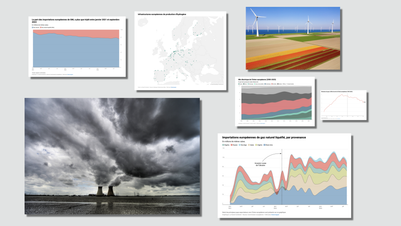article-en
June 27, 2023
Accelerating sustainable development with hydrogen
Accelerating sustainable development means speeding up the transition to a lower-carbon, higher-efficiency economy. This transition can be based on components that are familiar to us – such as innovation and finance – and it will require a concerted effort to keep pace with the climate agenda.

Accelerating sustainable development with hydrogen
In many ways, sustainable development and acceleration are contradictory concepts. The exponential growth of our extractive model is leading to a disconnect between our needs and the natural resources which sustain us. First and foremost, we need to reimagine our relationship with the natural world. Yet at the same time, we urgently need to speed up the transformation of our energy and raw materials cycles, because whatever lifestyles, modes of transport and consumption we move towards, we will always need energy. Energy is what differentiates us from other species: it gives us access to mobility and control over the way we live.
Accelerating sustainable development means speeding up the transition to a lower-carbon, higher-efficiency economy that is more in tune with our natural ecosystems. This transition can be based on components that are familiar to us – such as innovation and finance – and it will require a concerted effort to keep pace with the climate agenda.
Low-carbon and green hydrogen which is created from renewable energy sources aligns well with the climate agenda and is proving to be a valuable tool in the decarbonisation of heavy industry and transport. However, we must remove the obstacles to its widespread deployment. Hydrogen is useful for transforming renewable energy through electrolysis into a transportable energy carrier, from areas with potential to countries with shortages (such as Europe, Japan, Korea), as well as for decarbonising sectors where renewables are not sufficient, such as heavy industry and transport. Hydrogen’s share of final energy demand could reach 15-20%, compared with 2% today.
Accelerating through innovation and competitive green hydrogen
Innovation is a tool for unlocking some of the levers that are slowing down the industry’s ability to make green hydrogen competitive (yields and capex), to transport it efficiently (on its own or in competitive derivative forms), to store it sustainably, or to return it efficiently in electrical form.
Innovation certainly helps, but above all it benefits those who know how to take advantage of it. Ultimately, the Chinese model is the most advanced today, having overtaken the US. The Chinese strategy is based on a “trial and error” i.e., getting available technologies up-and-running as quickly as possible, with all their inaccuracies and inconsistencies in performance and reliability, as it recognises the opportunities they create for learning and making progress in the field. If we had listened to science and technology alone, we would never have got the solar or wind power industries off the ground, because the first units had performance levels of a just a few per cent and cost 10 to 20 times more than they do today. But it was by installing the first units that we were able to lower costs and benefit from the effect of scale with widespread public support.
It is obviously reassuring to have an enviable position in terms of patent registrations, but we’ve reached a stage of maturity with technologies such as fuels cells, tanks, and electrolysers, where we need to deploy now to make progress. While our regulatory discussions are getting lost in the intricacies of negotiations to align the interests of each European state instead of playing the “European view”, the Chinese are lining up 150 electrolyser suppliers, the largest deployments of manufacturing sites and units, the largest number of buses, lorries and hydrogen distribution stations. All these assets may not work very well – the performance of the units is mediocre – however there are many windfall effects from entrepreneurial players looking for subsidies and the market dynamic is very strong.
The system learns and thrives on competition. Prices remain tight and this gradually builds up a leading industry, as we have previously seen with steel, plastics, textiles, solar and wind power, and are now witnessing with batteries, nuclear power, hydroelectricity, a majority of the major heavy manufacturing sectors, semi-finished products and high-tech industries over the last two decades. What was cheap but of poor quality twenty years ago is now always cheaper and dominates the market. This is true for most of the industries that China has targeted (except still for semi-conductors and a few cutting-edge industries). Innovation today is first and foremost a question of entrepreneurship, speed to market and agility, which all require risk-taking appetite to launch new markets that are essential to the energy transition. Finally, not all energy innovations are relevant anymore unless they are highly disruptive and can be implemented quickly, because the climate challenge needs urgent action.
Accelerating through market finance
The second key component of the transition is finance. When it comes to hydrogen, yet again the challenge runs counter to the usual competitive logic of a traditional liberal economy: we don’t have the means to act in isolation and must increase the number of collaborative approaches.
So far, the industry’s approach has been relatively exemplary.
All the industries involved have come together through major regional organisations (such as Hydrogen Europe), and then globally through the World Hydrogen Council, to create a shared vision, fix minds on the key figures for hydrogen in the future global energy paradigm (15 to 20% of final demand in 2050) and the key segments that it would help to decarbonise, in addition to electrification.
In just a few years, this collaborative approach has enabled us to build a consensus.
FiveT Hydrogen AG then set about bringing together the financial players so that the leverage of infrastructure-type asset class approaches could be mobilised, which we did by creating the asset manager Hy24 in cooperation with Ardian. Through Hy24, major French and American manufacturers in the sector joined forces to invest in the first and largest fund in the world dedicated to low-carbon hydrogen.
This leverage makes it possible to reach out to long-term financial players, who are numerous, powerful with nearly €90,000 billion of capital under management, homogeneous in their expectations, and ready to deploy on a massive scale if the terms of the deal are clear, with competitive business models that price the future as a source of value.
The combination in an infrastructure fund such as the one deployed by Hy24 of industrialists and financiers creates unprecedented momentum. For an investment of €100 million in the fund, the market space opened is 20 times larger (€2 billion) and will enable €20 billion worth of projects to be mobilised, thanks to the fund’s collaborative approach to equity investment and its role in complementing public funding.
Now Hy24 has started to deploy its first green hydrogen production projects with pioneering entrepreneurs. But we are also engaging with Ardian the institutional players and sovereign wealth funds on a larger scale. By working together through the One Planet Sovereign Wealth Funds (OPSWF) and the Hydrogen Council on the question of the standards to be implemented to ensure the smooth circulation of hydrogen we hope to streamline the way for the deployment of the hundreds of billions required. Finance is a tool for the mass deployment and democratisation of hydrogen, based on a collaborative approach which brings together manufacturers, public authorities and key players in the deployment of tomorrow’s assets.
The climate agenda requires a change of economic pace
Finally, a change of pace is an essential component in the transition equation. The energy transition requires a roughly ten-fold increase of the current rate of investment in the renewable value chain, which means going from €500 billion to €5 trillion a year. That is significant, but it pales in comparison to what is at stake and global GDP, especially if we accept that the debt created to finance this will create value, energy, jobs, and resilience.
Hydrogen is a benchmark for the energy transition. The faster it develops, the quicker the pace that the most energy-intensive sectors are decarbonising. Hydrogen’s trajectory is emblematic of the transition and the new pace needed to meet the challenges of climate change. Over the next 10 years, more than 20 EJ of energy will need to be deployed in the form of hydrogen (France’s final consumption is around 5 EJ). Such a figure is probably unattainable within this timeframe if we compare it with the significant growth of LNG, which has reached 18 EJ in 40 years, or solar and wind power, which have gone from nothing to 6 and 8 EJ respectively over the last 20 years. This breakneck pace calls for adapted regulatory processes that are less complex, less time-consuming, and more agile.
The pace picks up in the right direction when the technologies are finally ready, the players are mobilised and the regulatory signals are firmly aligned. That’s what we’re seeing with solar and wind power. We can see how the changing policies to nuclear development in France have disrupted the industry, which now needs to start up again very quickly. Hydrogen represents a tremendous opportunity for decarbonisation, reindustrialisation and energy sovereignty, but there is a risk of delays if the rules are not clearly defined now. By 2024, the cursor on investment decisions has to pass the 10% mark worldwide – this represents €30 billion of projects decided on out of €300 billion announced, a proportion that is not moving, when it should be rising to around 30%.
This notion of sustainable development is forcing us to think differently about all aspects of energy and industrial policy, including hydrogen, and it is gradually redrawing the map of the world. The energy systems of the coming decades will have to adapt to areas with different resources and profiles, depending on whether we are in areas of high development, or undeveloped desert territories. There are pros and cons to each, with undeveloped land offering fewer land-use conflicts and far-reaching development potential for local players and regions in deficit. Ultra-developed regions however are rich in regulation and oversight to protect everyone’s particular interests, which can lead to stagnation and does not allow us to move quickly.
We cannot start to accelerate the energy transition without accepting that we must go fast when we can, and only slow down when it is no longer possible to go further. A new division of roles is therefore taking shape between European countries and others in the Global North and the Global South. For developing regions, overall economic development is perhaps more critical than sustainable development issues – however they have a unique chance to do both at the same time.
“Accelerating sustainable development” was one of the round table sessions organized during this year’s edition of Les Rencontres d’Aix in Aix-en-Provence, France. Pierre-Etienne was part of that session available online.

Innovating to finance the hydrogen economy
On the road to a more sustainable economy, we need more investment in sustainable assets. These investments must not only be supported by appropriate regulatory frameworks, but also encouraged and facilitated by financial mechanisms.
More about

Energy Europe – From integration to power
Europe is fragile. It's a fact: it will never have total energy independence. How can we take advantage of this situation? Pierre-Etienne Franc, co-founder and CEO of Hy24, proposes to turn a weakness into a strength - to the benefit of the Union's industrial and foreign policies.
More about

Report: Enabling CO2 standards, a policy toolkit to foster the implementation of AFIR in European Member States
The report was prepared by Hy24 with the contributions of Daimler Truck, Stellantis, Renault, Hyvia, BMW Group, Toyota, Hyundai, Honda, Air Liquide, TotalEnergies, Vinci Concessions, Air Products, Everfuel, Messer, H2Accelerate, Snam, Engie and H2 Mobility to stress the urgency of deploying the HRS network if we are to achieve the ambitious objectives set by AFIR and, more importantly, the decarbonisation targets for the transport sector.
More about
